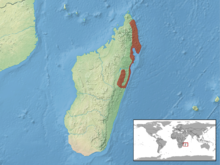| Furcifer bifidus | |
|---|---|

| |
| Taxidermied Furcifer bifidus (synonym: Chameleo bifidus). | |
| Conservation status | |
 Least Concern (IUCN 3.1) | |
| Scientific classification | |
| Domain: | Eukaryota |
| Kingdom: | Animalia |
| Phylum: | Chordata |
| Class: | Reptilia |
| Order: | Squamata |
| Suborder: | Iguania |
| Family: | Chamaeleonidae |
| Genus: | Furcifer |
| Species: | F. bifidus |
| Binomial name | |
| Furcifer bifidus Brongniart, 1800 | |

| |
| Synonyms | |
| |
Furcifer bifidus is a species of chameleon that is endemic to Madagascar. It was described by Alexandre Brongniart in 1800. The International Union for Conservation of Nature have ranked this species of chameleon as Least Concern.
Distribution and habitat
Furcifer bifidus is found in east Madagascar, and there is no known type locality. According to the International Union for Conservation of Nature (IUCN), it can be found over an area of 35,368 square kilometres (13,656 square miles), and is therefore ranked as a Least Concern species of animal, although it is exposed to many threats. It can be found on the east of Madagascar north after the Mangoro River, and as far as Daraina and Marojejy National Park (Marojejy Massif). It has been found at a highest of 700 metres (2,300 feet) above sea level. The two major threats to the Furcifer bifidus are logging for commercial reasons and the slash-and-burn method in agriculture. The species has been listed as protected.
Taxonomy
Furcifer bifidus was initially described by French chemist, mineralogist, and zoologist Alexandre Brongniart in 1800.
References
- ^ Jenkins, R.K.B.; Andreone, F.; Andriamazava, A.; Anjeriniaina, M.; Brady, L.; Glaw, F.; Griffiths, R.A.; Rabibisoa, N.; Rakotomalala, D.; Rakotondravony, H.; Randrianantoandro, J.C.; Randrianiriana, J.; Randrianizahana, H.; Ratsoavina, F.; Robsomanitrandrasana, E. (2011). "Furcifer bifidus". IUCN Red List of Threatened Species. 2011: e.T172937A6944687. doi:10.2305/IUCN.UK.2011-2.RLTS.T172937A6944687.en. Retrieved 12 November 2021.
- ^ "Furcifer bifidus | The Reptile Database". Reptile-database.reptarium.cz. Retrieved 2012-11-11.
- Charles Klaver Wolfgang Böhme; Charles J. J. Klaver (1997). Das Tierreich - The Animal Kingdom: A Characterization and Compilation of the Recent Animal Groups. Walter de Gruyter. pp. 17–. ISBN 978-3-11-015187-9. Retrieved 11 November 2012.
- "ITIS Standard Report Page: Furcifer bifidus". Itis.gov. Retrieved 2012-11-11.
| Taxon identifiers | |
|---|---|
| Furcifer bifidus | |